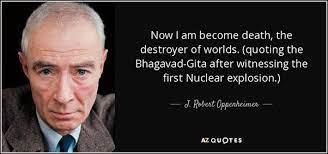Introduction
In the annals of scientific discovery, few names resonate as profoundly as Oppenheimer, a brilliant mind who played a pivotal role in unraveling the secrets of the atomic bomb. Oppenheimer's groundbreaking insights into nuclear fission and fusion not only reshaped the landscape of physics but also had far-reaching implications for the course of history. In this blog, we delve into the key discoveries made by Oppenheimer, shedding light on the intricacies of fission and fusion.
The Genesis of Oppenheimer's Research
Oppenheimer's journey into the realm of atomic bomb research began in the early 20th century, a time marked by geopolitical tensions and scientific fervor. The scientific community, driven by the potential of unlocking unprecedented energy, was exploring the nucleus of the atom. Oppenheimer, driven by an insatiable curiosity, immersed himself in the study of nuclear reactions, laying the foundation for his monumental contributions.
Fission Unveiled: Oppenheimer Key Insight
One of Oppenheimer's most notable breakthroughs was the elucidation of nuclear fission, a process that would become the cornerstone of atomic bomb technology. In 1938, Oppenheimer, along with his collaborators, conducted groundbreaking experiments that revealed the splitting of uranium nuclei when bombarded with neutrons. This revelation marked a paradigm shift in understanding the fundamental forces at play within the atom.
Nuclear fission involves the splitting of a heavy atomic nucleus into two or more lighter nuclei, releasing an immense amount of energy. Oppenheimerexperiments demonstrated that this process not only released energy but also emitted additional neutrons, creating a self-sustaining chain reaction. The implications were staggering, paving the way for the development of nuclear weapons.
Oppenheimer's research provided the theoretical framework for harnessing the energy released during nuclear fission for both destructive and constructive purposes. The atomic bomb, with its potential for devastating power, became a reality, and the world stood on the precipice of a new era.
From Fission to Fusion: The H-Bomb Revelation
While Oppenheimer's contributions to understanding fission were monumental, his journey did not end there. In the subsequent years, he turned his attention to nuclear fusion, the process that powers the sun and hydrogen bombs. Fusion involves the merging of light atomic nuclei to form a heavier nucleus, releasing even more energy than fission.
Oppenheimer's insights into fusion were crucial for the development of the hydrogen bomb, also known as the H-bomb. In 1952, the world witnessed the first successful test of an H-bomb, a device many times more powerful than its atomic counterpart. The key to the H-bomb's potency lay in Oppenheimer's understanding of the conditions required to initiate and sustain a fusion reaction.
The Fusion Dilemma: Challenges and Triumphs
Oppenheimer faced numerous challenges in unraveling the complexities of nuclear fusion. Unlike fission, which occurs at relatively lower temperatures, fusion necessitates extremely high temperatures and pressures to overcome the electrostatic repulsion between positively charged atomic nuclei. Oppenheimer's perseverance and innovative thinking led to the realization that the intense heat generated by an atomic bomb's fission stage could create the conditions required for fusion.
This groundbreaking concept, known as the "Teller–Ulam design," laid the foundation for the construction of hydrogen bombs. The fusion stage, ignited by the energy released during the fission stage, demonstrated Oppenheimer's ingenuity in solving one of the most formidable challenges in nuclear physics.
Ethical Considerations and Oppenheimer's Legacy
Oppenheimer's contributions to atomic bomb technology raise ethical questions about the responsibility of scientists in shaping the course of history. The destructive power of nuclear weapons, borne out of Oppenheimer's discoveries, prompted reflections on the moral and ethical implications of scientific advancements.
Despite the controversy surrounding the applications of his work, Oppenheimer's legacy is one of scientific brilliance and the pursuit of knowledge. His contributions, while contributing to the development of destructive weapons, also opened avenues for peaceful applications of nuclear energy, including electricity generation.
Conclusion
Oppenheimer's journey into the heart of atomic bomb discoveries marked a turning point in the history of science and geopolitics. His insights into nuclear fission and fusion reshaped our understanding of the atomic nucleus and paved the way for both the destructive power of nuclear weapons and the potential for peaceful applications of nuclear energy. As we reflect on Oppenheimer's legacy, we are reminded of the dual nature of scientific progress—a force that can be harnessed for both creation and destruction.







